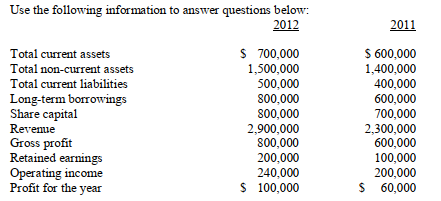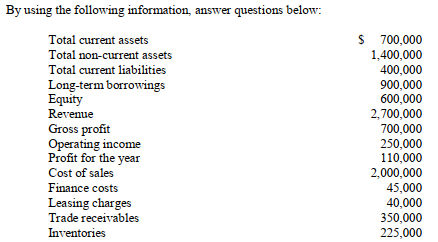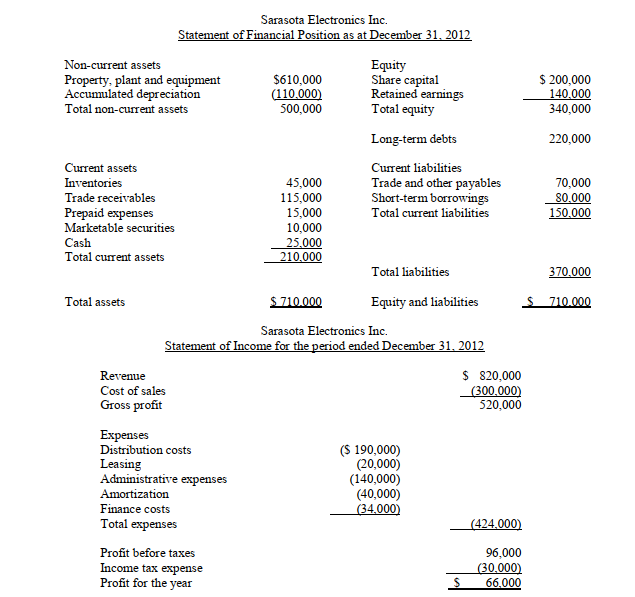Deck 4: Financial Statement Analysis
Question
Question
Question
Question
Question
Question
Question
Question
Question
Question
Question
Question
Question
Question
Question
Question
Question
Question
Question
Question
Question
Question
Question
Question
Question
Question
Question
Question
Question
Question
Question
Question
Question
Question
Question
Question
Question
Question
Question
Question
Question
Question
Question
Question
Question
Question
Question
Question
Question
Question
Question
Question
Question
Question
Question
Question
Question
Question
Question
Question
Question
Question
Question
Question
Question
Question
Question
Question
Question
Question
Question
Question
Question
Question
Question
Question
Question
Question
Question
Question

Unlock Deck
Sign up to unlock the cards in this deck!
Unlock Deck
Unlock Deck
1/256
Play
Full screen (f)
Deck 4: Financial Statement Analysis
1

-Calculate the net working capital in terms of dollars and as a percentage of total assets for both years:
Net working capital ____________ _____________
Ratios ____________ _____________

2

-Calculate the return on revenue ratio for both years:
Ratios ____________ _____________

3

-Calculate the profit margin on revenue ratio for both years:
Ratios ____________ _____________

4

-Calculate the return on equity ratio for both years:
Ratios ____________ _____________

Unlock Deck
Unlock for access to all 256 flashcards in this deck.
Unlock Deck
k this deck
5

-Calculate the return on total assets ratio for both years:
Ratios ____________ _____________

Unlock Deck
Unlock for access to all 256 flashcards in this deck.
Unlock Deck
k this deck
6

-Identify with a check mark, which ratios show an improvement between the two years:


Unlock Deck
Unlock for access to all 256 flashcards in this deck.
Unlock Deck
k this deck
7

-Calculate the net working capital's change in dollars and in percentage between the years 2012 and 2011:
In dollars _____________
In percentage _____________

Unlock Deck
Unlock for access to all 256 flashcards in this deck.
Unlock Deck
k this deck
8

-Calculate the shareholders' equity change in dollars and in percentage between the years 2012 and 2011:
In dollars _____________
In percentage _____________

Unlock Deck
Unlock for access to all 256 flashcards in this deck.
Unlock Deck
k this deck
9

-Calculate the total liabilities change in dollars and in percentage between the years 2011 and 2012
In dollars _____________
In percentage _____________

Unlock Deck
Unlock for access to all 256 flashcards in this deck.
Unlock Deck
k this deck
10

-Calculate the total assets' change in dollars and in percentage between the years 2011 and 2012
In dollars _____________
In percentage _____________

Unlock Deck
Unlock for access to all 256 flashcards in this deck.
Unlock Deck
k this deck
11

-Total assets turnover is: _____________

Unlock Deck
Unlock for access to all 256 flashcards in this deck.
Unlock Deck
k this deck
12

-Return on total assets is: _____________

Unlock Deck
Unlock for access to all 256 flashcards in this deck.
Unlock Deck
k this deck
13

-Profit margin on revenue is: _____________

Unlock Deck
Unlock for access to all 256 flashcards in this deck.
Unlock Deck
k this deck
14

-Return on equity is: _____________

Unlock Deck
Unlock for access to all 256 flashcards in this deck.
Unlock Deck
k this deck
15

-Debt-to-total assets is: _____________

Unlock Deck
Unlock for access to all 256 flashcards in this deck.
Unlock Deck
k this deck
16

-Debt-to-equity is: _____________

Unlock Deck
Unlock for access to all 256 flashcards in this deck.
Unlock Deck
k this deck
17

-Return on revenue is: _____________

Unlock Deck
Unlock for access to all 256 flashcards in this deck.
Unlock Deck
k this deck
18

-Times-interest-earned is: _____________

Unlock Deck
Unlock for access to all 256 flashcards in this deck.
Unlock Deck
k this deck
19

-Fixed-charges-coverage ratio is: _____________

Unlock Deck
Unlock for access to all 256 flashcards in this deck.
Unlock Deck
k this deck
20

-Average collection period is: _____________

Unlock Deck
Unlock for access to all 256 flashcards in this deck.
Unlock Deck
k this deck
21

-Inventory turnover is: _____________

Unlock Deck
Unlock for access to all 256 flashcards in this deck.
Unlock Deck
k this deck
22

-The current ratio is: _________________

Unlock Deck
Unlock for access to all 256 flashcards in this deck.
Unlock Deck
k this deck
23

-The quick ratio is: _________________

Unlock Deck
Unlock for access to all 256 flashcards in this deck.
Unlock Deck
k this deck
24

-The debt-to-total assets ratio is: _________________

Unlock Deck
Unlock for access to all 256 flashcards in this deck.
Unlock Deck
k this deck
25

-The debt-to-equity ratio is: _________________

Unlock Deck
Unlock for access to all 256 flashcards in this deck.
Unlock Deck
k this deck
26

-The times-interest-earned ratio is: _________________

Unlock Deck
Unlock for access to all 256 flashcards in this deck.
Unlock Deck
k this deck
27

-The fixed-charges coverage ratio is: _________________

Unlock Deck
Unlock for access to all 256 flashcards in this deck.
Unlock Deck
k this deck
28

-The average collection period is:_________________

Unlock Deck
Unlock for access to all 256 flashcards in this deck.
Unlock Deck
k this deck
29

-The inventory turnover is: _________________

Unlock Deck
Unlock for access to all 256 flashcards in this deck.
Unlock Deck
k this deck
30

-The capital assets turnover is: _________________

Unlock Deck
Unlock for access to all 256 flashcards in this deck.
Unlock Deck
k this deck
31

-The total assets turnover is: _________________

Unlock Deck
Unlock for access to all 256 flashcards in this deck.
Unlock Deck
k this deck
32

-The profit margin on revenue ratio is: _________________

Unlock Deck
Unlock for access to all 256 flashcards in this deck.
Unlock Deck
k this deck
33

-The return on revenue ratio is: _________________

Unlock Deck
Unlock for access to all 256 flashcards in this deck.
Unlock Deck
k this deck
34

-The return on total assets ratio is: _________________

Unlock Deck
Unlock for access to all 256 flashcards in this deck.
Unlock Deck
k this deck
35

-The return on equity ratio is:_________________

Unlock Deck
Unlock for access to all 256 flashcards in this deck.
Unlock Deck
k this deck
36

-Total non-current assets:_________________

Unlock Deck
Unlock for access to all 256 flashcards in this deck.
Unlock Deck
k this deck
37

-Inventories:_________________

Unlock Deck
Unlock for access to all 256 flashcards in this deck.
Unlock Deck
k this deck
38

-Total current assets: _________________

Unlock Deck
Unlock for access to all 256 flashcards in this deck.
Unlock Deck
k this deck
39

-Total equity:_________________

Unlock Deck
Unlock for access to all 256 flashcards in this deck.
Unlock Deck
k this deck
40

-Total current liabilities: _________________

Unlock Deck
Unlock for access to all 256 flashcards in this deck.
Unlock Deck
k this deck
41

-Total liabilities: _________________

Unlock Deck
Unlock for access to all 256 flashcards in this deck.
Unlock Deck
k this deck
42

-Cost of sales: _________________

Unlock Deck
Unlock for access to all 256 flashcards in this deck.
Unlock Deck
k this deck
43

-Total distribution costs: _________________

Unlock Deck
Unlock for access to all 256 flashcards in this deck.
Unlock Deck
k this deck
44

-Total administrative expenses: _________________

Unlock Deck
Unlock for access to all 256 flashcards in this deck.
Unlock Deck
k this deck
45

-Profit before taxes: _________________

Unlock Deck
Unlock for access to all 256 flashcards in this deck.
Unlock Deck
k this deck
46

-The current ratio is: _________________

Unlock Deck
Unlock for access to all 256 flashcards in this deck.
Unlock Deck
k this deck
47

-The quick ratio is: _________________

Unlock Deck
Unlock for access to all 256 flashcards in this deck.
Unlock Deck
k this deck
48

-The debt-to-total assets ratio is: _________________

Unlock Deck
Unlock for access to all 256 flashcards in this deck.
Unlock Deck
k this deck
49

-The debt-to-equity ratio is: _________________

Unlock Deck
Unlock for access to all 256 flashcards in this deck.
Unlock Deck
k this deck
50

-The times-interest-earned ratio is:_________________

Unlock Deck
Unlock for access to all 256 flashcards in this deck.
Unlock Deck
k this deck
51

-The fixed-charges coverage ratio is: _________________

Unlock Deck
Unlock for access to all 256 flashcards in this deck.
Unlock Deck
k this deck
52

-The average collection period is: _________________

Unlock Deck
Unlock for access to all 256 flashcards in this deck.
Unlock Deck
k this deck
53

-The inventory turnover is: _________________

Unlock Deck
Unlock for access to all 256 flashcards in this deck.
Unlock Deck
k this deck
54

-The capital assets turnover is: _________________

Unlock Deck
Unlock for access to all 256 flashcards in this deck.
Unlock Deck
k this deck
55

-The total assets turnover is: _________________

Unlock Deck
Unlock for access to all 256 flashcards in this deck.
Unlock Deck
k this deck
56

-The profit margin on revenue ratio is: _________________

Unlock Deck
Unlock for access to all 256 flashcards in this deck.
Unlock Deck
k this deck
57

-The return on revenue ratio is: _________________

Unlock Deck
Unlock for access to all 256 flashcards in this deck.
Unlock Deck
k this deck
58

-The return on total assets ratio is: _________________

Unlock Deck
Unlock for access to all 256 flashcards in this deck.
Unlock Deck
k this deck
59

-The return on equity ratio is: _________________

Unlock Deck
Unlock for access to all 256 flashcards in this deck.
Unlock Deck
k this deck
60
What is the best measure of a company's liquidity?
A) the quick ratio
B) the debt-to-total assets ratio
C) the current ratio
D) the times-interest-earned
A) the quick ratio
B) the debt-to-total assets ratio
C) the current ratio
D) the times-interest-earned

Unlock Deck
Unlock for access to all 256 flashcards in this deck.
Unlock Deck
k this deck
61
Why do managers analyze financial statements?
A) to review the company's profitability
B) to see whether or not the financial statements have been prepared in accordance with generally accepted accounting principles
C) to see how the company is performing and to use that information to determine whether budgets have been met and goals achieved
D) to examine the past to gauge past performance and use that information to enhance future performance
A) to review the company's profitability
B) to see whether or not the financial statements have been prepared in accordance with generally accepted accounting principles
C) to see how the company is performing and to use that information to determine whether budgets have been met and goals achieved
D) to examine the past to gauge past performance and use that information to enhance future performance

Unlock Deck
Unlock for access to all 256 flashcards in this deck.
Unlock Deck
k this deck
62
What is the "rule of thumb" for the-debt-to-total-assets ratio, and what does it mean?
A) The debt-to-equity ratio is 45%, which is a satisfactory debt-to-equity ratio.
B) The debt-to-total-assets ratio is 65%, and creditors may not provide more debt financing to the company.
C) The debt-to-total assets ratio is 50%, and creditors will provide more debt financing.
D) The debt-to-total-debt ratio is 50%, and creditors may be reluctant to provide more financing.
A) The debt-to-equity ratio is 45%, which is a satisfactory debt-to-equity ratio.
B) The debt-to-total-assets ratio is 65%, and creditors may not provide more debt financing to the company.
C) The debt-to-total assets ratio is 50%, and creditors will provide more debt financing.
D) The debt-to-total-debt ratio is 50%, and creditors may be reluctant to provide more financing.

Unlock Deck
Unlock for access to all 256 flashcards in this deck.
Unlock Deck
k this deck
63
What are the components of working capital?
A) current revenues and current expenses
B) operating assets and operating expenses
C) current assets and current liabilities
D) current assets and long-term borrowings
A) current revenues and current expenses
B) operating assets and operating expenses
C) current assets and current liabilities
D) current assets and long-term borrowings

Unlock Deck
Unlock for access to all 256 flashcards in this deck.
Unlock Deck
k this deck
64
What is removed from current assets to calculate the quick ratio?
A) marketable securities
B) cash
C) trade receivables
D) inventories
A) marketable securities
B) cash
C) trade receivables
D) inventories

Unlock Deck
Unlock for access to all 256 flashcards in this deck.
Unlock Deck
k this deck
65
Which of the following is a debt-coverage ratio?
A) inventory turnover
B) earnings per share
C) times-interest-earned
D) return on equity
A) inventory turnover
B) earnings per share
C) times-interest-earned
D) return on equity

Unlock Deck
Unlock for access to all 256 flashcards in this deck.
Unlock Deck
k this deck
66
What is the denominator of the times-interest-earned ratio?
A) finance costs
B) profit for the year
C) finance costs less income taxes
D) profit before taxes
A) finance costs
B) profit for the year
C) finance costs less income taxes
D) profit before taxes

Unlock Deck
Unlock for access to all 256 flashcards in this deck.
Unlock Deck
k this deck
67
Which of the following is an asset-management measure?
A) return on assets
B) times-interest-charges
C) average collection period
D) current ratio
A) return on assets
B) times-interest-charges
C) average collection period
D) current ratio

Unlock Deck
Unlock for access to all 256 flashcards in this deck.
Unlock Deck
k this deck
68
Which of the following is divided by inventory to calculate the inventory turnover ratio?
A) total assets
B) gross profit
C) cost of sales
D) operating expenses
A) total assets
B) gross profit
C) cost of sales
D) operating expenses

Unlock Deck
Unlock for access to all 256 flashcards in this deck.
Unlock Deck
k this deck
69
Which of the following is divided by total assets to calculate the total assets turnover ratio?
A) cost of sales
B) profit for the year
C) revenue
D) profit before taxes
A) cost of sales
B) profit for the year
C) revenue
D) profit before taxes

Unlock Deck
Unlock for access to all 256 flashcards in this deck.
Unlock Deck
k this deck
70
What is the profit margin on revenue performance measure related to?
A) operating income
B) gross profit
C) capital assets
D) working capital
A) operating income
B) gross profit
C) capital assets
D) working capital

Unlock Deck
Unlock for access to all 256 flashcards in this deck.
Unlock Deck
k this deck
71
Which of the following is a measure of profitability?
A) return on revenue
B) times-interest-earned
C) inventory turnover
D) quick ratio
A) return on revenue
B) times-interest-earned
C) inventory turnover
D) quick ratio

Unlock Deck
Unlock for access to all 256 flashcards in this deck.
Unlock Deck
k this deck
72
What is related to a company's performance under the DuPont financial system?
A) gross profit
B) revenue
C) total assets
D) equity
A) gross profit
B) revenue
C) total assets
D) equity

Unlock Deck
Unlock for access to all 256 flashcards in this deck.
Unlock Deck
k this deck
73
Which of the following is a measure of liquidity?
A) total assets turnover ratio
B) average collection period
C) return on revenue ratio
D) current ratio
A) total assets turnover ratio
B) average collection period
C) return on revenue ratio
D) current ratio

Unlock Deck
Unlock for access to all 256 flashcards in this deck.
Unlock Deck
k this deck
74
Which of the following is a measure of returns?
A) total assets turnover
B) quick ratio
C) average collection period
D) return on revenue ratio
A) total assets turnover
B) quick ratio
C) average collection period
D) return on revenue ratio

Unlock Deck
Unlock for access to all 256 flashcards in this deck.
Unlock Deck
k this deck
75
Which ratio measures solvency?
A) debt-to-equity ratio
B) return on total assets ratio
C) total assets turnover ratio
D) return on revenue ratio
A) debt-to-equity ratio
B) return on total assets ratio
C) total assets turnover ratio
D) return on revenue ratio

Unlock Deck
Unlock for access to all 256 flashcards in this deck.
Unlock Deck
k this deck
76
Which of the following helps measure growth in components of a financial statement?
A) common-size statement analysis
B) the cash budget
C) the DuPont financial system
D) horizontal analysis
A) common-size statement analysis
B) the cash budget
C) the DuPont financial system
D) horizontal analysis

Unlock Deck
Unlock for access to all 256 flashcards in this deck.
Unlock Deck
k this deck
77
Which of the following ratios tells us how management is managing the largest current asset in a company such as Future Shop or Best Buy?
A) The quick ratio.
B) The current ratio.
C) The debt-to-total assets ratio.
D) The inventory turnover.
A) The quick ratio.
B) The current ratio.
C) The debt-to-total assets ratio.
D) The inventory turnover.

Unlock Deck
Unlock for access to all 256 flashcards in this deck.
Unlock Deck
k this deck
78
Which of the following is NOT an asset-management ratio?
A) earnings per share
B) total assets turnover
C) inventory turnover
D) average collection period
A) earnings per share
B) total assets turnover
C) inventory turnover
D) average collection period

Unlock Deck
Unlock for access to all 256 flashcards in this deck.
Unlock Deck
k this deck
79
Which ratio is most likely to interest marketing managers?
A) debt-to-total assets
B) profit margin on revenue
C) current ratio
D) total assets turnover
A) debt-to-total assets
B) profit margin on revenue
C) current ratio
D) total assets turnover

Unlock Deck
Unlock for access to all 256 flashcards in this deck.
Unlock Deck
k this deck
80
What measures the productivity level of a business?
A) profit margin on revenue
B) current ratio
C) total assets turnover
D) average collection period
A) profit margin on revenue
B) current ratio
C) total assets turnover
D) average collection period

Unlock Deck
Unlock for access to all 256 flashcards in this deck.
Unlock Deck
k this deck



